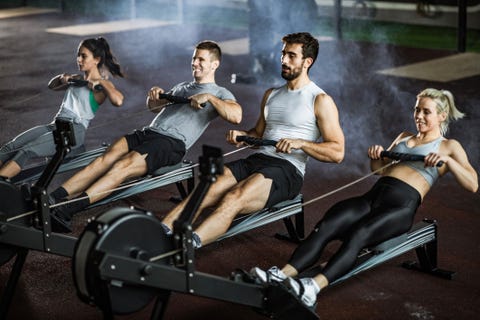Grab your grips and chalk because the fifth and final workout of the 2020 CrossFit Open is here. To close out the competition, you’ll take on a choose-your-own adventure of ring muscle-ups, rowing, and wall balls.
Unlike the four previous workouts this year, you can partition the workload however you want, which means that having a sensible strategy is more than important than ever. Below, you can find tips from Henning Langer, one of the exercise scientists behind WOD Science.
The 2020 CrossFit Open 20.5 Workout
Women’s Standard: 14-lb. ball to 9 ft.
Men’s Standard: 20-lb. ball to 10 ft.
Time cap: 20 minutes
The obvious bottleneck on 20.5 is the ring muscle-ups, so your strategy should revolve around that movement. If you know there’s no chance you can finish one rep, then you want to do the wall balls and row as quickly as possible or opt for the scaled version, which prescribes 40 chin-over-bar pullups instead. If you have any issues with your shoulders—or any concerns about the ring muscle-ups giving you problems—go for the pullups.
What’s the Deal With the CrossFit Open 20.5 Workout
If you want to try for (maybe your first ever) ring muscle-up, Langer has some advice about kipping, which might seem counterintuitive at first. Trust him on this one though, and keep your swinging to a minimum to start. “Most people would be surprised by how feasible a strict muscle-up might be, as opposed to a huge kip because the kip requires so much more coordination and timing and belief in yourself,” he says. However you attempt the muscle-up, just make sure you do it at the beginning of the workout and have a coach okay your form. Remember, the pullups are an option, one that you should definitely take if there’s any doubt about the rings.
If you can do 5 to 10 muscle-ups, you want to intersperse those with rowing—not wall balls—in order to save your biceps, triceps, and shoulders. “Similar to handstand pushups, if the ring muscle-ups die on you, then you have to wait disproportionately long for them to return,” says Langer. “If you get no repped, just stop the ring muscle-ups. Don’t wait for them to come back. Get onto the rower and row very slowly.”
If you eat ring muscle-ups for breakfast, you want to come out of the gates with a big set and then alternate between those and the wall balls, ideally saving the rowing for last. Then, you should pull hard. “It really pays off if you can row at higher intensity and higher wattage because the calorie output per stroke is higher,” says Langer.
A More Manageable Way to Handle the 20.5 Workout

skynesherGetty Images
A more manageable way to think about 20.5 is 10 rounds of 4 muscle-ups and 12 wall balls. If you take 45 seconds for each movement, you finish at 15 minutes, leaving 5 more for the row. Because the average man rows about 20 calories per minute, you should finish—in a perfect world—with a minute to spare.
Regardless of what strategy may get you the highest score, this is the final workout of the Open, and since you have the freedom to make it whatever you want, take it. If you want it to be a 20-minute EMOM of 2 ring muscle-ups, that’s what it is. If you prefer to finish the wall balls and row and then use your remaining time to fight for your first muscle-up, do it. No matter what, it’s unlikely you’ll finish everything. “Forty muscle-ups is a lot,” says Langer. “Forty will kill most people.”
Source: Read Full Article
